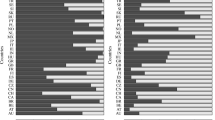Abstract
This paper examines the transmission effects of U.S. expansionary policies on inflation in the G7 countries under the latter years of the Bretton Woods system. Using quarterly data and structural vector autoregressions, this paper investigates the extent of inflation variability due to U.S. aggregate supply and aggregate demand impulses in major industrial countries. Empirical results show that a sizable proportion of inflation variability in these countries can be attributed to U.S. shocks. A brief discussion follows concerning the breakdown of Bretton Woods and implications for the design and functioning of international monetary arrangements.
Similar content being viewed by others
References
Bayoumi, Tamim; Eichengreen, Barry. "Macroeconomic Adjustment Under the Bretton Woods and the Post-Bretton-Woods Float: An Impulse Response Analysis,"The Economic Journal, 104, July 1994, pp. 813–27.
Blanchard, Olivier; Quah, Danny. "The Dynamic Effects of Aggregate Demand and Supply Disturbances,"American Economic Review, 79, 4, September 1989, pp. 655–73.
Bordo, Michael. "The Bretton Woods International Monetary System: A Historical Overview," in Michael Bordo; Barry Eichengreen, eds.,A Retrospective on the Bretton Woods System, Chicago, IL: University of Chicago Press, 1993, pp. 3–98.
Darby, Michael R.; Lothian, James R.; Gandolfi, Arthur E.; Schwartz, Anna J.; Stockman, Alan C.The International Transmission of Inflation, Chicago, IL: University of Chicago Press, 1983.
Economic Report of the President. Washington, DC: U.S. Government Printing Office, 1978.
Gali, Jordi. "How Well Does the IS-LM Model Fit Postwar U.S. Data?,"Quarterly Journal of Economics, 107, 2, May 1992, pp. 709–38.
Meltzer, Allan H. "U.S. Policy Under the Bretton Woods Era,"Federal Reserve Bank of Saint Louis Review, 73, May/June 1991, pp. 54–83.
Moore, Geoffrey H.; Moore, Melita H.International Economic Indicators, Westport, CT: Greenwood Press, 1985.
Niehans, Jürg. "How to Fill an Empty Shell?,"American Economic Review, 66, 2, May 1976, pp. 177–85.
Swoboda, Alexander K.; Genberg, Hans. "Gold and the Dollar: Asymmetries in the World Money Stock Determination, 1959–71," in Richard N. Cooper; Peter B. Kenen; Jorge B. De Macedo; Jaques van Ypersele, eds.,The International Monetary System Under Flexible Exchange Rates: Global, Regional, and National, Cambridge, MA: Ballinger, 1982, pp. 235–59.
Author information
Authors and Affiliations
Rights and permissions
About this article
Cite this article
Dibooğlu, S. Inflation under the Bretton Woods system: The spillover effects of U.S. expansionary policies. Atlantic Economic Journal 27, 74–85 (1999). https://doi.org/10.1007/BF02299179
Issue Date:
DOI: https://doi.org/10.1007/BF02299179




